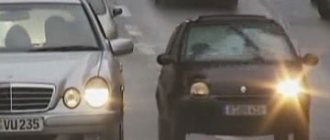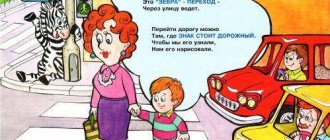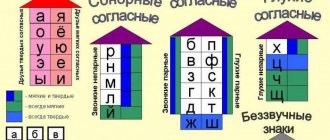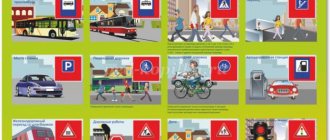Traffic rules for parents: how to cross the road with children correctly
Accidents on the roads occur regularly, so it is important for all pedestrians to remember the safety rules. It is not enough to just wait for the traffic light to turn green. There are several more important rules that all pedestrians, and especially parents, should remember. We tell you how to safely cross the road in different situations.
How to cross the road with a child
As stated in the traffic rules, pedestrians at a controlled crossing must follow the traffic lights. Before entering a pedestrian crossing, you should first assess the distance to approaching vehicles and make sure that the crossing will be safe.
You should also look carefully around (traffic police officers recommend looking three times: left, right and left again) at a controlled crossing, since drivers often do not have time to brake in time. Sometimes drivers driving in the left lane do not notice pedestrians entering the road because of cars stopped in the right lane.
You cannot stop on the roadway unless it is related to traffic safety. And even if a child drops a toy on the road, it’s not worth stopping for it. Before going out on the road, it is better to take things from the child’s hands.
If you are unable to cross the road, stop at the traffic island or median and continue driving when the light turns green again. Make sure that the child stands still and does not move forward or backward.
It is recommended to hold the child by the wrist (this will make it more difficult for him to slip out and move away from you) and lead him to your right. At the same time, you need to take your child by the hand at the moment when you are standing next to the crossing and waiting for the traffic light.
Crowd, thunderstorm, fire and stray dogs: the second part of “Safety Cards for Children” has been released
When crossing the road, do not talk on the phone, otherwise you may not hear the signal of an approaching car or traffic controller.
Never cross the road or start crossing if you see that the green traffic light has already begun to flash.
While waiting for a green traffic light, do not come close to the edge of the road - it is better to take a few steps back from it so that the child cannot accidentally jump out or lean out onto the roadway.
How to cross the road with a stroller
Before going out on the road with a stroller, be sure to pick up your child in your arms. But the stroller itself can be rolled in three ways. It is most convenient to roll the stroller in front of you, but this is the least safe option, since strollers are lower than cars. Drivers in the second row may not notice the stroller and continue driving. For the same reason, you should not carry a stroller with you. It is better to roll it from the side, to your right. This is not very convenient, but this way you will have time to push the stroller forward or pull it back.
How to cross the road with a child on a bicycle or sled
Bicycles, scooters and sleds must be carried by hand. Hold your child in your arms or by the wrist (children should always walk to the adult's right) and carry a bicycle or other vehicle in your free hand.
Read more about how to ride a bike correctly for children and adults here.
How to cross the road with a dog
On the road you need to monitor the safety of not only your child, but also your pet. You can cross the road only with dogs on a leash. Teach your dog the “Near” command and say it every time you approach the road. Before going out on the road, be sure to shorten the leash so that the dog cannot move away from you. It is better to pick up a small dog.
How to cross the road in the dark
When crossing or walking next to the road at night or in conditions of poor visibility (for example, during heavy rain or snow), pedestrians are advised to carry items with reflective elements (for example, clothing with reflective stripes). But outside populated areas, pedestrians are required to carry such items with them.
On July 16 in Moscow, an 18-year-old student hit three children who were walking along an unregulated pedestrian crossing, accompanied by their mother and grandmother. You can read more about the incident here. As it later became known, collisions with pedestrians on this section of the road had occurred before. Blogger Ilya Varlamov said that the accident was the result of poorly organized traffic.
More reading on the topic:
How to tell children about safety without scaring them. The psychologist explains
In Moscow, an 18-year-old student hit three children. What is known about the accident
In the Kurgan region, schoolgirls saved drowning children
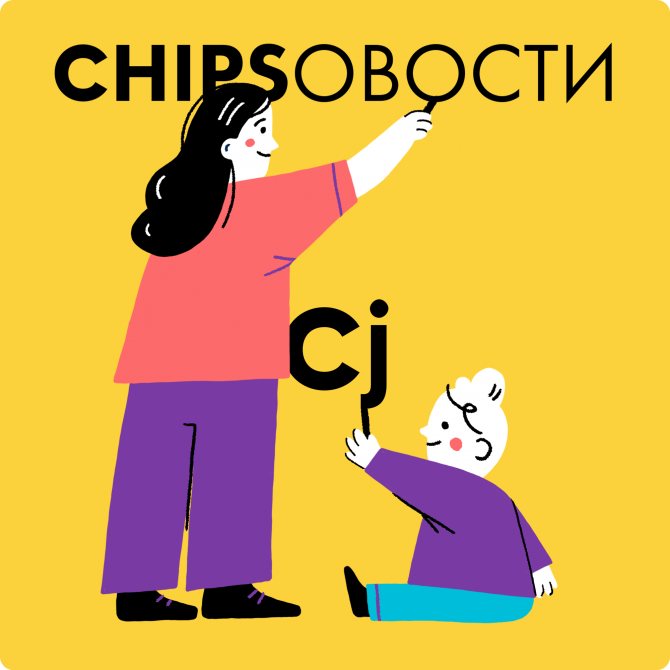
CHIPS news
Listen to our podcast


Traffic rules for younger schoolchildren
How to cross the road correctly
You might be surprised to see the headline and think, “Is it really that hard to cross the road?” Some pedestrians believe that you just need to run across the road very quickly and everything will be fine.
Others, on the contrary, wait patiently until there is not a single car on the road. But this happens so rarely that you can stand for several hours waiting for the moment when you can cross the road.
What to do? How to cross the road correctly?
You already know that you can cross the road using an overground or underground pedestrian crossing, as well as a green traffic light. But before you start crossing the road, determine whether the traffic on it is one-way or two-way. After all, the rules for crossing different roads differ from each other.
But first of all, you must know the general rules very well:
1. Before crossing any road, stop at the edge of the sidewalk.
2. Look carefully to the left and to the right and find out whether it is a one-way or two-way road.
3. Before you start crossing the road, make sure that all vehicles are at a safe distance from you for crossing.
4. Cross the roadway at a brisk pace, but do not run.
5. Cross the road at right angles to the sidewalk, not diagonally.
And the most important thing:
Be very careful the entire time you are crossing the road!
How to properly cross a two-way road
You already know that when crossing any road you must be very careful and follow the general rules. But, in addition to the general ones, there are also rules when crossing two-way roads.
How should you behave when crossing a two-way road?
1. Before you start crossing, you need to stop at the edge of the sidewalk and make sure that in front of you is a two-way street.
2. Then you need to look to the left and make sure that there is no traffic near the pedestrian crossing.
3. Now you need to look to the right to see if there are any cars nearby that are moving on the opposite side of the road. If they are, then you will have to stop when you reach the middle of the roadway and let these cars pass. But standing in the middle of the roadway is dangerous. In such cases, it is better not to start crossing the road.
4. Make sure there are no cars on your side of the road driving on the right. After all, there may be cars that move in reverse, or cars that remove snow or debris.
5. Start crossing the road only when you are sure that you are at a safe distance from cars moving along it.
6. Remember that you need to cross the road quickly, but calmly. No need to run! After all, while running it is very difficult to notice how the environment changes.
7. When you reach the middle of the road, be sure to look to the right. Go further only if you see that there is no transport nearby.
8. If you reach the middle of the roadway and see that cars are driving on the right, not far from you, stop! Don't try to cross the road, let all the cars pass.
9. If you stop in the middle of the roadway, don’t step back a single step! While you were walking to the middle of the road, a car could drive up to the pedestrian crossing from the left and end up close to you. Therefore, when you are in the middle of the roadway, do not run forward and do not retreat sharply back! Look left and right carefully to avoid unpleasant surprises.
10. Cross the road at right angles, not diagonally. Then you will have a clear view of the road both left and right.
It may seem to you that there are too many rules and it is difficult or even impossible to remember them. But it is much better to spend time learning the rules of crossing the road than to risk your health and life!
Before crossing a two-way road, first look to the left, and when you reach the middle of the roadway, look to the right.
How to properly cross a one-way road
When crossing a one-way road, you need to behave a little differently than when crossing a two-way road. When approaching a one-way road, first of all, determine where the traffic is going along it - to the right or to the left.
Before you start crossing a one-way road, remember that you can only cross it immediately. It is impossible to stop in the middle of the road here! After all, on such a road cars travel across the entire width of the roadway. Therefore, let us remind you once again: when crossing a one-way road, you will not be able to stop in the middle.
Now you understand that you can cross such roads only when you are absolutely sure that all vehicles are at a distance sufficient from you for safe crossing. Therefore, first of all, make sure that the transport is far from you, and remember the braking distance!
Don't forget to make sure that there are no cars driving in reverse near the pedestrian crossing. Start crossing the road only when you are sure it is completely safe.
Cross the road quickly, but don't run. Walk at right angles to the sidewalk, not at an angle. Why - you already know.
When crossing a one-way road, do not forget to watch the side where the traffic is coming from.
We recommend watching:
Road users. Why are traffic rules needed?
The history of the emergence of traffic rules. History of traffic lights
How does a traffic light work?
Can the vehicle stop immediately?
The road and its components
Features of the classes
It is known that children learn skills best through play. For this purpose, lesson plans have been developed for teaching behavior on the road, and in some preschool educational institutions training sites have been organized for practicing the skills of crossing roads and using traffic lights.
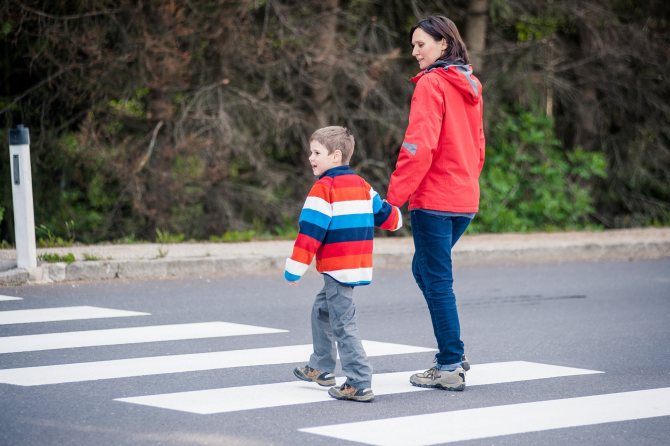
Zebra crossing
Duration of classes
When conducting classes, children of a specific age group have their own standard of time during which the child can maintain attention without overwork:
- in the younger group the time interval is 15 minutes;
- in medium - 20 minutes;
- in the preparatory room - 25-30 minutes.
Note! In accordance with these data, a lesson plan is already being drawn up.
Approximate lesson plan for traffic rules “Traffic Light” in the younger group:
- Introductory part - 2 min.
- Main part - 10 min. (conversation with children on the topic “What is a traffic light and why is it needed”, collective activity (making a “Traffic Light” application).
- Summing up, praise - 3 min.
Approximate lesson plan for traffic rules “Traffic on the road” in the senior group:
- Introductory part - 3 min. (what did people use before the invention of the car).
- Main part - 13 min. (discussion using pictures of what is on the road, its elements, the game “Traffic Controller”).
- Summing up - 4 min. (what was easy and what seemed difficult).
Scenarios and quests for interactive classes in the preparatory group
Compound:
- Introductory part 4 min.
- Basic 20 min.
- Result: assessment of your own knowledge and how you coped with the tasks.
The teacher praises the children that they all did well, namely:
- collected road signs from puzzle pieces, told what they mean, divided the signs into categories (prohibitory, warning, special, prescriptive);
- answered questions (where you can cross the street, how traffic is regulated, what a pedestrian crossing is, why you need to look first to the left and then to the right when crossing the road);
- solved riddles about the bus, tram, traffic light.
Safe behavior on the street - communicating with strangers
You can introduce a character into the game. For example, Dunno is riding on a bus, and he needs to be explained how to behave on public transport, is it possible:
- talk loudly;
- distract the driver;
- touch doors and lean against them;
- lean out of the window;
- litter;
- eat something;
- give way.
74-70-69
Children are the most vulnerable road users. And responsibility for their lives and health lies entirely with adults.
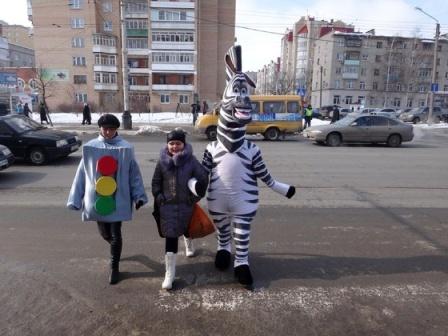
Children are taught the simplest and most necessary rules of behavior on the road, starting in kindergarten. In schools, teachers work with them and inspectors conduct classes. But still, children spend most of their time at home, with their parents. It is parents who must instill in their children a culture of behavior on the road. And sometimes, as it turns out, they themselves do not know simple safety rules.
Let's start by crossing the roadway. Or rather, from crossing the road by young mothers with strollers. According to numerous observations, almost all parents with strollers cross the road incorrectly: they roll it in front of them, not paying attention to the fact that the stroller is lower than the parked car, and the driver simply cannot see it from the road.
There are three options for crossing the roadway with a stroller. The first is when we push it in front of us. This is the most common and most dangerous method. Why is he dangerous? Even if one, the right row of cars stopped to let you pass, then from the second, left row, the driver may not notice the stroller, since it is below the level of the car. The view of the road is lost, and therefore control over the situation.
The second option is that we carry the stroller behind us. Also unsafe, because in this case we control the situation in front of us, but do not see what is happening behind us.
The safest is the third method, when we keep the stroller on the right side of us. Only in this case does the mother have the opportunity, if a critical situation arises, to pull the stroller back or push it forward.
In winter, some parents take their children on sleds. And here there are peculiarities. The sled is even lower than the stroller, and in this case the risk that the driver will not notice them when turning is even higher. It is impossible to carry a sled at your side, so the only correct solution is to take the child in your arms, no matter whether you are crossing the road at a pedestrian crossing or not.
The same goes for bicycles. We often see this picture in the summer. A mother is crossing the road, and a child is riding next to her on a tricycle. And the mother does not understand that at this moment the baby is completely unprotected. If he just runs over a pebble, the baby will lose his balance and fall off the bike onto the roadway. Before going out onto the road, the child must get off the bike. Agree, it is not difficult for a mother to carry a tricycle in one hand, and with the other to take her child by the hand and move him. Moreover, here, as with a stroller, the “right hand” rule applies - the child should always be to the right of the adult. And you need to hold it not by the hand, but by the wrist. A child is unpredictable: if he suddenly sees something on the other side of the road and runs, his palm will easily slip out of your hand.
By the way, even when you walk along the sidewalk, especially one located close to the roadway, guide your child to your right. Cases where people are hit on sidewalks have become more frequent: a car can be thrown out during a collision, a car can easily jump over the curb if the driver loses control when turning... Even when you are waiting for a green traffic light, do not stand at the very edge of the roadway, move away to half a meter Anything can happen on the road. And you will always have time to cross the roadway.
A pedestrian crossing is a safety zone if pedestrians follow the crossing rules and drivers follow the rules of passage.
We advise parents not to go out onto the road as soon as the light turns green. Firstly, to be honest, there are drivers who, in violation of the Rules, try to jump through a yellow traffic light and cross the crossing already at the moment when the green light turns on for pedestrians.
Secondly, there are cases when drivers, in full compliance with the Rules, complete the maneuver in order to clear the intersection. This happens especially often at large intersections. Therefore, despite the traffic light permitting, make sure once again that all cars have stopped.
Finally, when crossing the road, do not talk on the phone, do not be distracted - “listen” to the street. In order to react in time to the signal that a driver can give in case of danger, or to the whistle of a policeman who regulates traffic.
And most importantly, teach this to your child.
If parents transport their children in special restraints, it is important to install and secure them correctly, otherwise they will not provide any safety. If you constantly travel with your child in a car, it is better to install the seat once and for all. Also, choose the safest place for it. The safest place in a car, especially for a child, is in the middle, where he is protected from side impacts. One of the reasons for the safety of the middle rear seat is that it has much more space than other seats, which is not “squashed” in a collision, including a side one.
Many young parents are now preparing for childbirth in advance and buying a car seat and a child car seat along with the stroller, but for grandparents, who take their grandchildren much less often, it is expensive to buy a seat.
Indeed, many grandparents, when an inspector stops them on the road, begin to explain that there is a seat, but it remained in the car of the child’s parents. This is not an excuse. Even if you feel confident on the road and have been driving a car for a long time, you are not insured against a traffic accident that may occur due to the fault of another driver. There are many such cases. A child under 12 years of age must be in a restraint system. Now there are a huge number of them, you can choose for every taste and budget. More recently, for example, inflatable children's chairs have appeared. They inflate very easily, literally in 10-15 seconds. And they deflate just as easily when the chair is not needed. Fold it up and take it with you in the glove compartment. In addition, they are durable, as they are made of durable material, which is used, for example, to make rafting boats. A unique combination of compactness and safety, ideal for grandparents.
By the way, the problem for grandparents is not only that they, as a rule, transport their grandchildren without seats. They cross the road with their grandchildren at risk of death. It must be admitted that traffic intensity and the rules themselves change, but the behavior of older people on the road does not. There used to be a rule: go around the bus from the back, the tram from the front. Now you need to wait for the transport to leave and only then cross the road. But older people lived by their previous knowledge and continue to live. Remind the grandparents to whom you entrust your children how to behave correctly on the road.
1. Why can’t you cross the road when the traffic light is yellow?
A yellow signal prohibits movement for both drivers and pedestrians. But if the vehicle was at the intersection when the yellow signal turned on, the driver will no longer be able to stop the car. He has the right to pass through the intersection so as not to create problems for pedestrians or other vehicles.
2. Why is it dangerous to cross the road?
When a person runs, it is difficult for him to see what is happening around him. And if you are in a hurry, you may fall, not notice a car leaving the alley, etc.
3. Where should a pedestrian go if there is no sidewalk?
When there is no sidewalk, pedestrian path or curb, you need to walk in one row along the edge of the roadway. Outside the city, pedestrians in such cases must walk towards traffic.
4. Why can’t you cross the road diagonally?
When you walk diagonally, you turn your back to the cars and may not see them. In addition, the path becomes longer, you spend more time on the roadway.
5. What can happen if you get off the bus at the last moment?
The driver will see in the mirror that no one is there and will begin to close the doors. If you are late to leave, the doors may pinch you. In this case, you can fall and end up under the wheels of a bus.
6. Why is it dangerous to cross the road together arm in arm or holding hands?
When a whole column of children crosses the road, it is safe to hold hands. When two or three people are crossing, this should not be done (of course, if the student is not leading his younger brother or sister), because when danger appears, the children can pull each other in different directions and lose precious seconds.
7. What should a pedestrian remember when getting off a bus?
After getting off the bus, you need to move away from it, giving way to those getting off and waiting to board. There is no need to rush to cross the road: a standing bus makes it difficult to notice passing traffic. Therefore, you cannot run out from behind him - neither in front nor behind. Walk to the crossing or (if there is none) wait until the bus leaves the stop and you will have a clear view of the road.
8. What are the dangers when you walk down the street with small children?
Small children do not yet know how to navigate the road and can break free and run at the most inopportune moment. The elders should hold the younger ones tightly by the wrist and not let them go. You need to be especially careful when you drive up to your home and get off a bus, tram, taxi, or trolleybus. Small children, noticing someone they know on the other side of the street, can break free and run towards them.
9. Why is the moment dangerous for a pedestrian when one car overtakes another?
For some time, the first car covers the second. A pedestrian can only see one car and will not notice an overtaking car. How dangerous is it for a pedestrian when two oncoming cars pass each other? One car pulls out from behind another. Therefore, both the driver and the pedestrian may not notice each other.
10. Is it possible to be distracted when crossing the road?
Of course not. On the road, a car travels 10-12 meters or even more in a second. But we love to look back at the noise, the scream, especially when we hear our name. This is a very dangerous habit.
11. You have come to a crossroads. It showed a green signal for pedestrians. For how long, you don't know. Is it worth starting the transition?
It is better to wait for the next green signal cycle so as not to find yourself at a crossing when the traffic light is red. This is especially important in rainy weather or winter when the road is slippery.
12. What should you do if you dropped your bag, briefcase or some other item while crossing the road?
If we drop something, our first reaction is to quickly pick it up. When crossing the road, this habit can serve you badly. If we immediately bend down and pick up an object, our attention will be focused only on it. You can't do that on the road. You must first look in both directions of the road, make sure that there is no danger, and then pick up your “lost item.” It’s better, of course, to be collected during the transition and not drop anything.
13. The boy is in a hurry to go to the cinema and is late. A truck is approaching the crossing, but the boy sees that it will have time to cross. What is the danger of such a situation?
There are two dangers. Firstly, another car may be following the truck, hidden for now from the boy’s eyes. Secondly, when crossing, the boy will only watch the approaching truck and may forget to look in the other direction.
14. Why is it dangerous to play near the road?
While playing, you can forget about the danger, run out onto the road and get hit by a car.
15. At an uncontrolled intersection, a pedestrian let a car pass; he cannot see any other cars. Is it possible to transfer?
You can’t let a car pass right away. In the first seconds, while she is close, the oncoming person may be hidden behind her. Having let a car pass, you need to wait until it drives further away and does not interfere with your inspection of the street.
16. A pedestrian began to cross the street when the traffic lights changed from green to red. The pedestrian decided: “While the cars are standing still, I’ll be in time: after all, the drivers see me and won’t run over me.” What is a pedestrian's mistake?
Not all cars are standing at this moment; some are approaching the intersection, and when the green signal turns on, they will enter the intersection on the move. Such a driver may not notice a crossing pedestrian because of standing cars. And the pedestrian also does not see this car because of the standing traffic.
17. Why is it necessary to cross the road at pedestrian crossings?
The driver knows that pedestrian traffic is allowed in these places, he reduces his speed and is more attentive. A pedestrian who crosses the road in the wrong place can get hurt and interfere with the flow of traffic.
18. Why can’t you cross the road when the traffic light is red or yellow?
When the light is red for pedestrians, the light is green for drivers. Seeing a green signal, the driver drives quickly, without waiting for pedestrians to appear.
19. Why is it dangerous to cross the road?
When a person runs, it is difficult for him to observe, to see the roadway, the approaching car.
20. What is the danger of going out onto the road because of a parked car?
When a car is stationary, it blocks the view of the road; a pedestrian cannot see another car that is driving behind the stationary one. We must remember: if the car is stationary, danger may be hidden behind it.
21. Why can’t you walk on the roadway?
Even walking along the edge of the road is dangerous; a car can hit you. You only need to walk on the sidewalk.
22. Why is a pedestrian crossing without a traffic light more dangerous than a crossing with a traffic light?
Crossing without a traffic light is more dangerous because you need to be able to determine whether the car is far away, whether it is going fast or slow. At the same time, because of a slowly moving car, could an oncoming car drive out?
23. Why is crossing dangerous when one car overtakes another?
At the moment when one car overtakes another, the speed of the overtaking car is much greater. A pedestrian may not notice an overtaking car. The driver of an overtaking car may also not notice the pedestrian.
24. How many meters will the car go when braking if the driver wants to stop?
Depending on the speed, it can move 36-46 meters. Much more in icy conditions. In addition, while the driver presses the brakes, the car will travel several meters without braking.
25. Why is it dangerous to play near the road?
While playing, you can forget about the danger, run out onto the road and get run over by a car.
26. What should a person get off the bus remember?
The fact that a stopped bus makes it difficult to notice approaching traffic. You have to wait until the bus leaves the stop.
27. How should one step from the sidewalk onto the roadway?
You always need to stop to look around and get ready for the transition.
28. What is the danger of rushing on the street?
When a person is in a hurry, he is not so attentive; in this state it is easy to not notice a moving car.
29. What if a pedestrian has to step out onto the road because of trees, bushes, etc.?
Pause and examine the part of the road that was hidden behind the object.
30. Why can’t you cling to vehicles?
Because you can fall off and get hit by the wheels of the car you are attached to, or the car that is driving behind you.
31. How is pedestrian traffic regulated?
Traffic lights, road markings, signs, road signs, traffic controllers.
32. Where and why are metal fences installed?
They are installed in areas of heavy pedestrian and vehicle traffic and limit the possibility of crossing the roadway in the wrong place.
33. At what age are children allowed to ride a bicycle outside?
From the age of 14.
34. Where should you wait for the tram?
You need to wait for the tram opposite the stop on the sidewalk or on a specially marked area.
35. What cars are allowed to run a red light?
Ambulance, police, fire, city gas.
36. How to get around a stationary tram?
A stationary tram must be walked around in front to avoid getting hit by an oncoming tram.
37. What are sidewalks for, and how should you move along them?
Sidewalks are used for pedestrian traffic. Pedestrians must move towards each other, keeping to the right in each direction. You are not allowed to play or jostle on the sidewalks.
38. Where should a pedestrian stop if he does not have time to finish crossing the roadway?
At a traffic island or at the intersection of the center line with the pedestrian crossing line.
39. Why is it dangerous to walk and run along the roadway?
The roadway is intended only for traffic, and a pedestrian on it interferes with traffic. This can lead to an accident, as you may not have time to assess the road situation. In addition, drivers do not expect that pedestrians can walk or run along the roadway and may not notice the pedestrian.
40. In our region there are many cases when children get hit by a car moving in reverse in the courtyards. Why does this happen? What should children do?
It is dangerous for children to be and play in the back of a car because the driver only partially sees what is happening behind him, and is often deprived of the opportunity to see a small child.
41. Where can I play in the yard?
Only in a special area designated for play, where cars and motorcycles are not allowed.
42. Why do we need road markings (lines, inscriptions, etc.) applied to the roadway with white paint?
It establishes a certain order of movement. It indicates where certain types of transport should move, and where pedestrians can cross the street.
43. Why are pedestrian crossings installed on the streets? What are they?
Pedestrian crossings are places to cross the street from one side to the other. Pedestrian crossings can be underground, above ground or overground. If there is a pedestrian crossing, you should only cross the street along them. Transitions can be regulated or unregulated. The first ones are equipped with a traffic light.
44. How to cross the street at a pedestrian crossing?
It is allowed to cross the street if the permissive (green) traffic light is on. Before you step onto the roadway, you need to look around and make sure that the cars have stopped. If an approaching car is moving at high speed (maybe the driver did not see the signal), let it pass. You need to cross the street even more carefully and cautiously at an unregulated pedestrian crossing.
45. What does a red traffic light mean?
The red signal prohibits movement.
46. What does the combination of red and yellow signal mean?
Movement is prohibited during these signals. They warn about the upcoming turn on green.
47. What is the main rule when crossing the street?
You need to cross it only in designated places - at intersections and pedestrian crossings, but the most important thing is to provide yourself with a good view of the road to the right and left. Try never to cross where visibility is poor (there are cars, bushes, trees and other obstacles). If possible, move away from standing cars, bushes and other objects that interfere with your inspection of the road.
48. What should you do if you have to cross the street next to a parked car or other obstruction to your view?
It may turn out that way. That just where the crossing is allowed, a car has broken down or is parked. In such cases, you need to approach a standing car (or other object that obstructs your view), stop and look out carefully, only after making sure that there is no hidden danger can you cross.
49. Why is it necessary to cross the road at intersections and at pedestrian crossings?
The driver knows that pedestrian traffic is allowed in these places, he reduces his speed and is more attentive. A pedestrian who crosses in the wrong place can get hurt and interfere with drivers.
50. Why can’t you cross the road when the traffic light is red or yellow?
When Red is on for pedestrians, Green is on for drivers. Seeing a green signal, the driver drives quickly and does not expect pedestrians to appear. Even if there are no cars visible, you must resist the urge to cross and wait for the green signal.
51. Why is it dangerous to cross the road?
When a person runs, it is difficult for him to observe, to see. And when crossing the road, the main thing is to look carefully on both sides, because the road is also deceptive: it seems that it is safe, and suddenly a car pulls out from an alley or from behind another car.
52. Why is it dangerous to cross the road diagonally?
When you walk diagonally, you turn your back to the cars and may not see them. In addition, the transition path becomes longer.
53. How does the driver see the bus passengers?
The driver monitors boarding and disembarking and passengers in the cabin through special mirrors. Therefore, he does not need to turn his head to see what is happening behind him.
54. What can happen if you are late getting off the bus?
The driver will see in the mirror that there is no one there and will close the doors; if you are late getting out, he may get pinched by the doors. If you fall, you may get run over.
55. What is the danger of entering the roadway because of a parked car?
When a car is stationary, it blocks the view of the road, and a pedestrian may not notice another car that is driving behind the stationary one. Trucks, buses, trolleybuses, and trams are especially dangerous and block the view of the road. But cars can also prevent you from seeing danger. We must remember: if there is a car parked on the street, there may be danger hidden behind it.
56. Why is a road with very few cars dangerous?
A pedestrian may think that the road is empty and begins to cross without looking both ways. And a car may suddenly appear - it will drive out of the yard, out of the alley. When crossing the road, you should always look both ways carefully.
57. How to determine whether a car is far or close?
It is necessary to determine how long it will take for the car to travel to the place where the pedestrian is standing. If it’s long, then the car is far away. If it's only a few seconds, it means close. Sometimes it seems that the car is far away, but if it is driving fast, it is dangerous to cross the road. When crossing the roadway, it is necessary to take into account the speed of traffic.
58. Why can’t you walk on the roadway?
It’s dangerous to walk even along the edge of the roadway—you might get hit by a car. You should only walk on sidewalks.
59. How to walk on a road that has no sidewalk?
When there is no sidewalk (outside the city), you need to walk along the side of the road, facing the traffic, in order to see the cars coming towards you.
60. What danger often arises when a schoolchild approaches his house?
Having noticed his house, the student will want to quickly cross the roadway to get home, and may not notice the car that is driving along the road at that moment.
61. How to determine that a car driver is about to turn right?
The car occupies the right lane, the right flashlight turns on and flashes - the turn signal.
62. Why are cars with trailers dangerous?
Firstly, when turning, the trailer skids and can hit pedestrians. Secondly, an inattentive pedestrian, seeing that the body of a car has passed by, may begin to cross the street and get hit by a trailer.
63. Why is it dangerous to cross the road together, arm in arm or holding hands?
When a whole column of children crosses the road, it is safe to hold hands. When two or three are crossing, this should not be done, because when danger appears, the children may begin to pull each other in different directions and lose the most valuable seconds.
64. Why is a pedestrian crossing without a traffic light more dangerous than a crossing with a traffic light?
Crossing without a traffic light is more dangerous, because you need to be able to determine whether a car is far or close, whether it is going fast or slow, and you need to be able to notice a small car or motorcycle. At the same time, often because of a slow-moving car, another one that is driving quickly gets out; because of a car that has passed, an oncoming one can get out.
65. Does the driver of a car that approaches him always see a pedestrian?
Not always: The driver has to watch many other drivers and pedestrians.
66. What are the dangers of driving on the road with small children?
Small children do not yet know how to navigate the road and can break free and run at the most inopportune moment. The elders must hold the younger ones tightly and not let them go when they try to escape. This happens especially often when getting off a bus, trolleybus, tram, taxi, in front of your house, when parents, comrades or acquaintances appear on the other side of the street.
67. Why is the moment dangerous for a pedestrian when one car overtakes another?
At this time, one car pulls out from behind another, the speed of the overtaking car is much greater. A pedestrian may not notice an overtaking car until it moves ahead, but then it will be too late. The driver of an overtaking car will also not see the pedestrian until he pulls out from behind the car he is overtaking.
68. Why is it dangerous for a pedestrian when two oncoming cars pass each other?
Here, too, one car leaves behind another. Therefore, the driver and the pedestrian may not notice each other, because visibility will be blocked by the car.
69. How many meters will the car go when braking if the driver wants to stop?
Even when a person wants to stop running, he will “jump” two meters. And the car needs, depending on the speed, 10, 15, and 20 meters. In addition, while the driver presses the brake, the car will travel several meters without braking.
70. Is it possible to look back when crossing the road?
Of course not. On the road, a car travels 10-12 meters or even more in a second. But we are accustomed to looking around when there is noise, shouting, when someone calls, without thinking whether we should succumb to this habit.
71. You approached an intersection: while you were approaching, the green light was on all the time. Is it possible to transfer?
If the street is relatively wide, more than 10-12 meters, it is better to wait so as not to find yourself at a crosswalk or in the middle of the roadway when the traffic light is red, the next green signal cycle.
72. Why is it dangerous to stand in the middle of the street?
When a person stands in the middle of the street, “on the center line,” cars are passing behind him, he does not watch them. But standing in traffic and not watching out for them is dangerous. If you are frightened by an approaching car, you can, out of habit, take a step back - right under the wheels of the vehicle passing behind you. Standing in the middle of the street, you need to be very collected and attentive, not take a single step without looking. On streets where there are a lot of cars moving, it is better to time the crossing so that you do not have to stand in the middle between two oncoming traffic flows.
73. What should you do if a pedestrian drops a bag, briefcase or some other item while crossing the road?
In such a situation, we are used to immediately bending down and lifting, while distracting ourselves from observation. You can't do that on the road. You must always look first, make sure there is no danger, and then bend down. And it’s best to be collected during the transition and not drop anything.
74. The boy is in a hurry to go to the cinema and is late. A truck is approaching the crossing, but the boy sees that it will have time to cross. What is the danger?
There are two dangers. Firstly, another car may not be visible behind the truck, which is traveling at a higher speed and is still hidden from the boy. Secondly, while crossing, the boy will watch the approaching truck and may forget to look in the other direction.
75. Why is it dangerous to play near the road?
While playing, you can forget about the danger, run out onto the road and get hit by a car.
76. At an uncontrolled intersection, a pedestrian let a car pass, no more cars are visible. Is it possible to transfer?
You can’t let a car pass right away. In the first seconds, while she is close, the oncoming person may be hidden behind her. Having let a car pass, you need to wait until it drives further away and does not interfere with your inspection of the street.
77. The pedestrian approached the intersection. While he was approaching, the green light was on, and the pedestrian was ready to cross. Suddenly the light turned red. The pedestrian decided this: while the cars are standing still, I’ll be in time. After all, drivers see me and won’t run over me. What is the pedestrian’s mistake that he did not take into account?
Not all cars are stopped at this moment; some are approaching the intersection and, when the green signal turns on, will enter the intersection on the move. Such a driver may not notice a crossing pedestrian because of standing cars, and the pedestrian does not see this car because of standing vehicles.
78. When you approached a pedestrian crossing “without a traffic light”, the cars were standing, the main group of pedestrians had already walked half of the roadway. Is it possible to transfer?
When the main group of pedestrians has passed, drivers of stationary cars are ready to start moving. At this time, they follow the main group of pedestrians with their eyes and may not notice a late pedestrian. Therefore, crossing the road in such a situation is dangerous.
79. What is the danger of rushing on the street?
When a person is in a hurry, he always thinks about one thing - how to go faster and not waste time. In this condition it is easy not to notice the car. Most accidents on the roads occur when children are in a hurry, worried, or engrossed in conversation or play.
80. How should you step from the sidewalk onto the roadway: immediately or first pause? Why?
You always have to pause. Firstly, to better inspect the roadway. Secondly, to get ready for the transition. Because on the roadway you need increased attention, not the same as on the sidewalk.
81. There is a car parked near the entrance of your house. The driver left. What could be the danger?
A stationary car blocks or limits your view of the road. Because of it, you may not notice another car, motorcycle, or cyclist.
82. Why do some pedestrians cross the street wherever they please, and even diagonally?
There is no culture of behavior, endurance, willpower, or respect for drivers.
83. Why are cyclists and motorcyclists at greatest risk on the road?
The stability of two-wheeled vehicles is many times lower than that of four-wheeled vehicles. Its size is many times smaller and it is often not noticed. Devices for signaling maneuvers on a car are incomparably better than on a motorcycle and bicycle, so motorcyclists and cyclists have to give hand signals, which they do not always do skillfully. In addition, in some cases hand signals are subtle: twilight, inclement weather, etc. And lastly: the experience of motorcyclists and cyclists is often insufficient for safe operation.
84. Why do some pedestrians cross the street when the traffic light is red?
There is no restraint, discipline, respect for drivers who find it more difficult to drive a car, when pedestrians cross in an unorganized manner and violate traffic rules.
85. Which turn is more dangerous, left or right, and why?
Left turns are much more dangerous. The driver has to cross two lanes: his own - you can collide with a passing car that is approaching from behind, it is not always easy to notice, and the oncoming lane - you must let oncoming traffic pass.
86. The green light is on for cars, but they are standing still. Why can they stand? Is it dangerous or safe to cross?
Crossing in such a situation is very dangerous: cars can stand waiting for permission to turn during a traffic jam, allowing an ambulance, fire truck or other special vehicle to pass. Cars can stand in one row, and cars can pass in another row (hidden behind the standing ones).
87. What is the danger of a bus when it approaches a stop?
The entrance to the bus stop is usually heavily traveled. In inclement weather or in winter, the bus may slip (skid) and even drive out onto the site. In addition, the pedestrian himself may slip and get run over. Or he may be accidentally pushed, especially when there are many passengers at the stop. Therefore, you need to carefully watch the bus approaching the stop and not come close to it until it comes to a complete stop.
88. What to do if a pedestrian has to go out onto the road close to a parked car: trees, bushes?
Pause and examine the part of the road that was hidden behind the object.
89. You want to catch up with a friend not far from the road. What danger threatens your comrade?
While running away, he may run onto the roadway without noticing the car.
90. On the edge of the sidewalks of a street with little traffic, a group of schoolchildren are chatting animatedly. Possible dangers?
Someone, being sure that there is no car, can step onto the road without looking.
91. What should a pedestrian get off a bus remember?
The fact that a standing bus makes it difficult to notice passing traffic, so you cannot get out or run out from behind it - neither in front nor behind.
Basic rules of behavior on the road for pedestrians
Natalia Galayda
Basic rules of behavior on the road for pedestrians
BASIC RULES FOR SAFE BEHAVIOR ON THE ROAD FOR PEDESTRIANS
1. Never run out onto the road in front of an approaching car - the driver cannot stop the car right away.
2. Cross the roadway only in designated places at pedestrian crossings, making sure that approaching traffic on the left and right allows you to pass .
3. Cars parked on the sidewalk block your view of the road . Therefore, you first need to look out from behind a standing car, assess the situation and make sure it’s safe to cross.
4. When getting off a bus or trolleybus, do not run out onto the road . Wait until he drives away, and only then, after making sure that there are no cars, cross the road .
5. When exiting the tram, walk onto the sidewalk, go to the nearest pedestrian crossing and cross the roadway.
6. Do not run out onto the road outside the pedestrian crossing zone ; in this place the driver does not expect pedestrians and will not be able to instantly stop the car.
7. You are not allowed to ride on the roadway on skateboards or roller skates.
8. It is dangerous to play ball and other games near the roadway; it is better to do this in the yard or on the playground.
RULES TO FOLLOW!
1. cross the street only when the traffic light is green;
2. cross the street in appropriate places, making it clear to drivers of your intention, so as not to force them to brake suddenly;
3. move on sidewalks;
4. use the underground passage, if available;
5. do not walk near the roadway;
6. do not accumulate at bus stops, forcing other pedestrians to leave the sidewalk ;
7. give way to parents with baby strollers;
8. do not walk along a narrow sidewalk arm in arm or hugging each other, occupying it entirely.
9. All these rules should be dictated by good upbringing and a sense of respect for others.
10. Realize that "zebra"
does not guarantee complete security.
Of course, you can think the other way around and run across the road . You will be right , but you risk getting maimed or worse. Do you agree that being a disabled person is not the best option?
11. When approaching the road , look at the approaching car, showing your intention to go to the zebra crossing.
.
12. Only after making sure that the driver has seen you and started to slow down, and he is at a sufficient distance from you, can the pedestrian the road .
13.Be careful: just because the driver starts to stop does not guarantee that he won’t run into you. The road can be slippery, the tires on the wheels are “bald”
, the brakes are bad. It is better to wait until the car comes to a complete stop.
14. Always assume that an overtaking car may well be driving in the second lane, and its driver may not see you.
15. Walk along the crossing at a normal pace. You should not run across, but also “crawl”
No need.
16. In some situations, it wouldn’t hurt to nod your head to the driver who missed you as a sign of gratitude.
The Traffic Rules say : “ A pedestrian is a person who is outside a vehicle on the road and is not working on it. Persons moving in wheelchairs without motors, driving a bicycle, moped, motorcycle, carrying a sled, cart, child stroller or wheelchair are considered pedestrians . ”
This means that pedestrians are all people walking along the road , and even if they are carrying a bicycle, moped or motorcycle next to them, they are also pedestrians .
RULES OF CONDUCT FOR PEDESTRIANS
Pedestrians must move on sidewalks or pedestrian paths , and in their absence, along the sides. (If there are no sidewalks, footpaths or shoulders , or if it is impossible to move along them, pedestrians can move along a bicycle path or follow each other along the edge of the roadway.)
On a country road, pedestrians must walk towards the movement of vehicles. Pedestrians moving in wheelchairs without a motor, as well as those driving a bicycle, moped or motorcycle next to them, must follow the direction of travel of vehicles.
Pedestrians can cross the carriageway at pedestrian crossings , and if there are none, at intersections along sidewalks or roadsides. In the absence of a pedestrian crossing or intersection, a pedestrian is allowed to cross the road at right angles to the edge of the roadway in an area without a dividing strip or fences. In this case, the road should be clearly visible in both directions.
When there is a traffic controller on the road , pedestrians must follow his signals. Pedestrian traffic can also be regulated by a pedestrian traffic light . In the absence of a traffic controller and a pedestrian traffic light, you must be guided by the signals of the transport traffic light.
At unregulated pedestrian crossings, pedestrians may enter the roadway only after they have assessed the distance to approaching vehicles and are convinced that the crossing will be safe.
When crossing the roadway outside a pedestrian crossing, pedestrians should be especially careful. A pedestrian should not enter the roadway due to any obstacle (a car standing at the sidewalk, etc., interfering with the view of the roadway, until he is convinced that there are no approaching vehicles. Once out on the roadway, pedestrians should not linger or stop, unless it is related to ensuring traffic safety.
Pedestrians who do not have time to complete the crossing must stop on the center line dividing traffic flows in opposite directions , or on a “safety island”
.
It will be possible to continue the crossing only after making sure that further movement is safe and if the traffic light signal (regulator)
allows the crossing.
When approaching a car with a blue flashing light and special sound signals, pedestrians are required to refrain from crossing the roadway, and those on the roadway are required to immediately vacate it (step back or quickly cross to the desired side, giving way to such a vehicle .
Let's look at the general safety measures that must be observed when pedestrians move on the roads .
When leaving the entrance of the house, pay attention to whether a car, motorcycle, moped, or bicycle is approaching you.
If there is a car parked near the house or trees growing that block your view, before entering the roadway, look around to see if there is a moving vehicle behind the obstacle.
When driving on the sidewalk, always stay on the right side so as not to interfere with oncoming pedestrian or interfere with traffic.
When walking along the sidewalk past a gate or garage exit, you need to pay attention to whether a car is leaving.
When preparing to cross the road , you need to inspect the roadway. Let us repeat that pedestrians cross the roadway at pedestrian crossings or at intersections.
Traffic rules for children. Rules for young pedestrians
Tatyana Sergeevna
Traffic rules for children. Rules for young pedestrians
PEDESTRIAN TRAFFIC RAVILA
When participating in road traffic, we are all pedestrians . And when moving on foot, we most often walk on sidewalks or pedestrian and bicycle paths , and in order to cross the roadway, we use pedestrian crossings .
Pedestrian crossings are places specially equipped so that pedestrians can safely cross the roadway. They are underground, aboveground and above ground. Let's get to know them better.
Overground and underground pedestrian crossings are the safest places to cross the road, since traffic and pedestrian do not intersect at such crossings. They are indicated by road signs.
An overpass looks like a bridge over the roadway, and an underground one looks like a tunnel under the road. Underground passages can most often be seen in large cities, but overground passages are found almost everywhere: in large cities, in small ones, and on country highways. Basically, such crossings are installed in places where traffic is very intense. These are not only the safest, but also the most convenient places to cross the road, because no one has to wait for the traffic light to turn green.
The above-ground pedestrian crossing is the well-known zebra crossing.
.
It is indicated by the sign 5.35.1, 5.35.2 “
Pedestrian crossing ” and horizontal road markings 1.14.1, 1.14.3, 1.14.4 (
zebra crossing,
including red and white) - indicates an uncontrolled
pedestrian crossing ; marking 1.14.3 indicates a pedestrian crossing with an increased likelihood of traffic accidents; Marking 1.14.4 indicates the crossing point for blind pedestrians ;
1.14.2, 1.14.5 - indicate a pedestrian crossing where traffic is regulated by a traffic light; Marking 1.14.5 indicates the crossing point for blind pedestrians ;
IMPORTANT: There is another sign, which is also called “
Pedestrian crossing ” (1.32)
- triangular, with a red border.
Where this sign is installed, DO NOT CROSS THE ROAD! This sign is for drivers, not pedestrians . It is installed 50-150 meters before the zebra crossing
and warns drivers that there is
a pedestrian crossing ahead and pedestrians .
If traffic at a pedestrian crossing is regulated by a traffic light, then such a crossing is called controlled. pedestrian in cities are almost universally equipped with pedestrian traffic lights . They have two signals - red and green. When crossing the road, pedestrians are required to follow the signals of the pedestrian traffic light .
Only if pedestrian traffic light, pedestrians should be guided by the signals of the transport traffic light (it has three signals: red, yellow and green)
.
If there is no traffic light, then the crossing is considered unregulated.
To cross the road at a controlled pedestrian crossing , you must wait for the green pedestrian traffic light . It is absolutely forbidden to cross, let alone run across the road when it is red, even if there are no cars! This is dangerous! But remember: a green signal allows movement, but it does not mean that you can cross the road without looking back.
The pedestrian must ensure his own safety
How? Here are four simple steps.
1. Before crossing the road, stop at its edge to assess the road situation.
2. Look around carefully several times.
3. Make sure that all cars have stopped and are allowing you to pass.
4. Only after this begin the transition. During the transition, continue to monitor the road conditions.
Walk quickly, but don't run. When a person runs, he does not look around. Turning your head while running is not only difficult, but also downright dangerous: you can fall. But when walking, a person can easily turn his head to the right and left .
Quite often there are situations when the light is red for pedestrians , for transport (in the same direction )
- green.
This happens when, simultaneously with moving straight ahead, passing traffic is also allowed to turn, the trajectory of which intersects “your” pedestrian crossing .
Therefore, be careful if a traffic light has an additional green section. IMPORTANT: Do not start the transition immediately after the green light turns on. You must first make sure that all cars have stopped and there are no “lagging” ones.
cars whose drivers try to
“overshoot”
the traffic lights at the moment the signals change.
And if you approach the crossing when the green signal starts flashing (or if you see that there is little time left on the countdown board that many pedestrian traffic lights with), you should not cross, although crossing is allowed. You may not have time to cross the entire roadway part before the green signal changes to red, and this is already dangerous.
at the unregulated pedestrian crossing. Therefore, cross the road along such a zebra crossing
must be done with double caution.
Before crossing, it is important not only to make sure that all cars have stopped and are allowing pedestrians , but also that there are no approaching cars whose drivers may not notice pedestrians crossing the roadway.
Therefore, the safest way to cross such a crossing is to let ALL approaching cars pass. IMPORTANT: It is dangerous to stand on the very edge of the sidewalk, on the curb stone. There is a risk that passing cars may hit you. Try to stand half a step or a step from the edge of the roadway.
Other situations for safe behavior
While at the station, you should remember that you cannot go beyond the security line at the edge of the passenger platform.
Note! You need to take off your headphones or hood so that nothing prevents you from noticing the approaching train.
It is life-threatening to play on platforms, cross tracks in the wrong places, and climb under stationary trains.
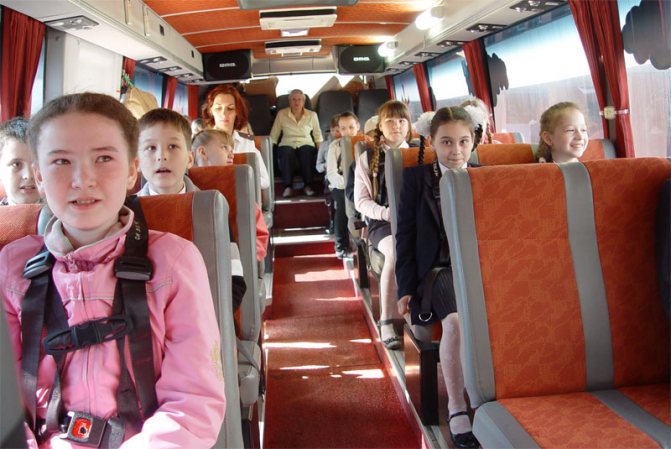
Child behavior on the bus
Child passenger in a private car
While in the car, the child must be seated in a car seat, fastened with a seat belt. It is strictly forbidden to distract the driver, lean out of the window, or throw objects through it, as this can lead to an emergency situation and injuries.
